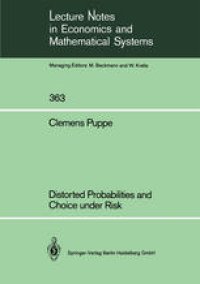
Ebook: Distorted Probabilities and Choice under Risk
Author: Clemens Puppe (auth.)
- Tags: Economic Theory, Operation Research/Decision Theory
- Series: Lecture Notes in Economics and Mathematical Systems 363
- Year: 1991
- Publisher: Springer-Verlag Berlin Heidelberg
- Edition: 1
- Language: English
- pdf
During the development of modern probability theory in the 17th cen tury it was commonly held that the attractiveness of a gamble offering the payoffs :1:17 ••• ,:l: with probabilities Pl, . . . , Pn is given by its expected n value L:~ :l:iPi. Accordingly, the decision problem of choosing among different such gambles - which will be called prospects or lotteries in the sequel-was thought to be solved by maximizing the corresponding expected values. The famous St. Petersburg paradox posed by Nicholas Bernoulli in 1728, however, conclusively demonstrated the fact that individuals l consider more than just the expected value. The resolution of the St. Petersburg paradox was proposed independently by Gabriel Cramer and Nicholas's cousin Daniel Bernoulli [BERNOULLI 1738/1954]. Their argument was that in a gamble with payoffs :l:i the decisive factors are not the payoffs themselves but their subjective values u( :l:i)' According to this argument gambles are evaluated on the basis of the expression L:~ U(Xi)pi. This hypothesis -with a somewhat different interpretation of the function u - has been given a solid axiomatic foundation in 1944 by v. Neumann and Morgenstern and is now known as the expected utility hypothesis. The resulting model has served for a long time as the preeminent theory of choice under risk, especially in its economic applications.
This book provides a systematic, formal treatment of a recently proposed extension of the expected utility model of choice under risk: the so-called rank-dependent utility model. In this approach the representation of preferences is based upon a (generalized) utility function defined on the outcome/probability-plane. The main purpose of the book is to demonstrate the flexibility of this model with respect to its explanatory power. This is achieved by analyzing a certain subclass of the rank-dependent utility approach which incorporates the notion of price-dependent distortions of probabilities. This particular approach captures an optimistic point of view towards gambling (as can often be observed), whilst being compatible with a suitably formulated concept of risk aversion. The resulting model is used to explain some of the observed behavioral patterns as the Allais-paradox and the behavior described by the Friedman-Savage hypothesis.
This book provides a systematic, formal treatment of a recently proposed extension of the expected utility model of choice under risk: the so-called rank-dependent utility model. In this approach the representation of preferences is based upon a (generalized) utility function defined on the outcome/probability-plane. The main purpose of the book is to demonstrate the flexibility of this model with respect to its explanatory power. This is achieved by analyzing a certain subclass of the rank-dependent utility approach which incorporates the notion of price-dependent distortions of probabilities. This particular approach captures an optimistic point of view towards gambling (as can often be observed), whilst being compatible with a suitably formulated concept of risk aversion. The resulting model is used to explain some of the observed behavioral patterns as the Allais-paradox and the behavior described by the Friedman-Savage hypothesis.
Content:
Front Matter....Pages I-VIII
Introduction....Pages 1-7
Axiomatic Utility Theory under Risk....Pages 8-39
A Rank-Dependent Utility Model with Prize-Dependent Distortion of Probabilities....Pages 40-66
Risk Aversion....Pages 67-87
Conclusion....Pages 88-91
Back Matter....Pages 92-104
This book provides a systematic, formal treatment of a recently proposed extension of the expected utility model of choice under risk: the so-called rank-dependent utility model. In this approach the representation of preferences is based upon a (generalized) utility function defined on the outcome/probability-plane. The main purpose of the book is to demonstrate the flexibility of this model with respect to its explanatory power. This is achieved by analyzing a certain subclass of the rank-dependent utility approach which incorporates the notion of price-dependent distortions of probabilities. This particular approach captures an optimistic point of view towards gambling (as can often be observed), whilst being compatible with a suitably formulated concept of risk aversion. The resulting model is used to explain some of the observed behavioral patterns as the Allais-paradox and the behavior described by the Friedman-Savage hypothesis.
Content:
Front Matter....Pages I-VIII
Introduction....Pages 1-7
Axiomatic Utility Theory under Risk....Pages 8-39
A Rank-Dependent Utility Model with Prize-Dependent Distortion of Probabilities....Pages 40-66
Risk Aversion....Pages 67-87
Conclusion....Pages 88-91
Back Matter....Pages 92-104
....